Greenhouse for cucumbers (53 photos)
Greenhouse for cucumbers: types and details of production

- Features
- Varieties of designs
- How to do it yourself?
- Manufacturing materials
- Dimensions
- Selection and preparation of location
- Examples of finished models
Perhaps one of the most sought-after garden plants are cucumbers. What only applications we do not find him! These are fresh salads, pickles, marinades, and even in homemade cosmetics, they are indispensable. But growing them in the way of an open ground on a personal plot is associated with certain difficulties - they are quite gentle and capricious, especially for temperature zigzags. Therefore, many gardeners prefer to build greenhouses and greenhouses for these lovers of the sun.

Features
Even novice growers are familiar with the device of simple polyethylene film shelters. It would seem that what is difficult here is to make a greenhouse for cucumbers. But "borage" has some design features:
- they must be at least one and a half meters high - this is done to tie cucumber strings (we also need special attachments for the ropes);
- cucumbers do not tolerate temperature fluctuations, so you need to think about the ventilation system and protection from hot sunlight;
- plants need space, since their need for macro-and micronutrients is quite high;
- for pollination of flowers, unrestricted tolerance of insect pollinators is needed (except for self-pollinating varieties).






When arranging greenhouses should be aware of maintaining the desired mode of light, humidity and temperature. To do this, you need to build a heating and ventilation system, as well as proper watering of the plants.
Varieties of designs
There are several basic types of cucumber greenhouse construction:
- hut;
- bookcase (for installation on the veranda or balcony);
- arched or tunnel configuration;
- butterfly;
- large greenhouses.



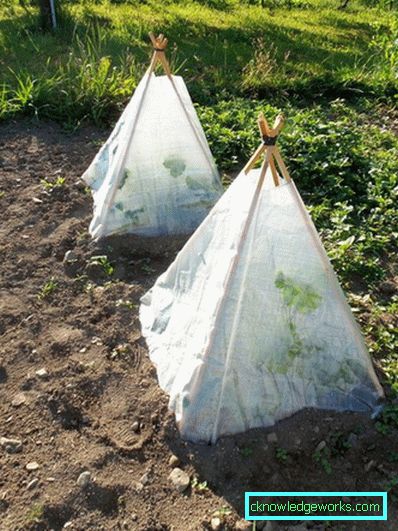


The length of the greenhouse depends on the desire of the owners. The optimal height of greenhouses is 150 cm, doors are not mounted in them, they do not require, in contrast to greenhouses, the installation of heating and lighting systems. The necessary temperature under the shelter is provided by the sun and the heat that produces overheating compost. There are both stationary and portable (made according to German technology) construction of greenhouses, folding, sliding models.

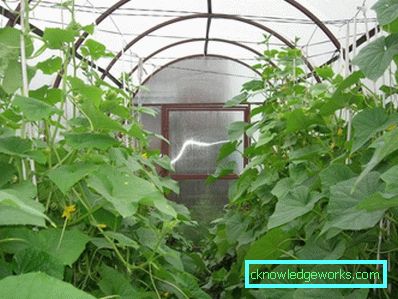
You can build in different ways - to build the most original temporary shelter of the film or glazed greenhouse. Just first you need to think about for what purpose and for how long the greenhouse is needed, to calculate the financial costs. Of course, there are ready-made models, but they may not like because of the narrow choice of sizes and high prices, especially since you still have to mount it with your own hands.

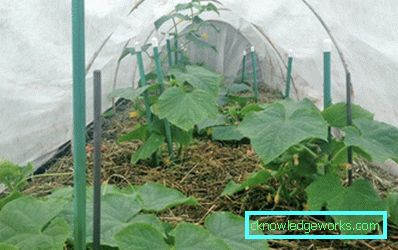
It is easier and cheaper to use scrap materials, such as construction residues. In this case, each person calculates all sizes, and the greenhouse will reliably protect the cultivated varieties.
How to do it yourself?
The hotbed-hut - perhaps the simplest of the "borage", which is easy to install on any personal plot. It is better to install it in a place closed from gusts of wind, it would be good if in the middle of the day there was a shadow from the trees, a fence or a house.
To deploy this design will require:
- bars section 4x4 cm;
- narrow slats;
- rope;
- nylon mesh;
- greenhouse film.
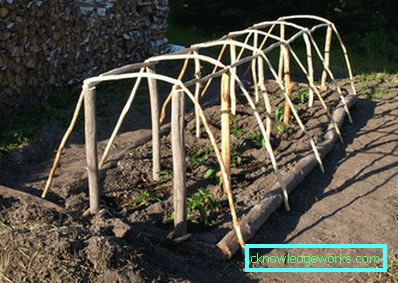

How to build a homemade greenhouse-hut, it will be clear from the description.
- Mark the landing area. Summer residents usually recommend such bed sizes - 1x3 m.
- From the 4 bars of 2.5-meter length at the edges of the intended landing, install two side triangles approximately 150 cm high.
- Put intermediate supports. Put the 3-meter bar through the points of the upper intersection of the bars and fasten it with supports.
- For stability, place additional vertical bars under the jumper bar.
- Attach the slats to the side walls of the greenhouse for reliable adhesion of the film coating to the frame.

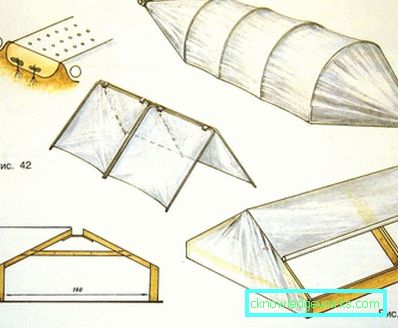
- Tie the planks together with a prepared rope. Summer residents advise after that to cover the frame with a net of nylon - to bind the plants and better secure the base of your hut.
- Now you can cover the finished base with film. On one side, additional fixation of the plastic with the slats is needed, the other is only to be pressed to the ground with some kind of load to quickly lift the film. Secure plastic from the ends of the greenhouse.
- Then get to the bed itself. Sprinkle the soil with a mixture of sawdust and ash (a glass of ash on a bucket of sawdust) in a thick layer 5 centimeters high, then cover with humus one and a half decimeters thick, then - 25 cm of fertile soil (for this, mix earth, humus and sand). Dampen everything with water and close the greenhouse. After a week you can use it for its intended purpose - to sow seeds or plant seedlings.
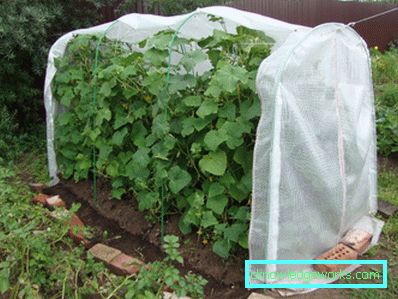
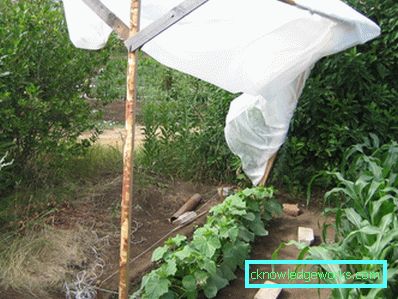
The arched configuration is very convenient, practical and reliable. It is usually made of agrofibre or spunbond. The use of these materials has its advantages - moisture does not condense under them, they allow air, light and heat to pass through well. Such ready-made structures can be purchased from many manufacturers of greenhouses, but you can do it yourself. Keep in mind that its height should be at least one and a half meters, since tall varieties are usually grown in it.
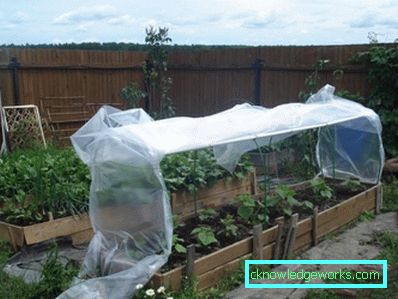
For an arched greenhouse you will need the following:
- 6-7 three-meter pieces of thick wire, fiberglass reinforcement or metal-plastic pipes;
- 12-14 tubes with a length of 40 cm each for fastening the arches;
- coating size 3x5 m (from agrofibre or spunbond);
- rope.

First, the arches are bent so that they are 1.5–1.6 m in height and 1–1.2 m wide. Then, in the section prepared for the bed, it is necessary to drive the prepared tubes into the ground in two rows, deepening them by 25 see. The distance between these vertical tubes should be 50-60 cm, the row-spacing should be 1–1.2 m. Then, insert the arches into the tubes and tie them together with a rope. To increase the stability of the rope from the end arches tie to the stakes driven into the ground at a distance of one and a half meters from the structure. Cover the greenhouse with a selected covering material and press its edges with a weighting agent (you can just stones).

Everything, your greenhouse tunnel in full readiness. Now you need to cook a garden and you can start growing cucumbers. Arches serve as a support for garter plants. If necessary, the greenhouse cover can be removed entirely or slightly tipped upward, opening access to fresh air and insects and at the same time protecting it from the scorching sun.
Greenhouses, "butterflies" are called so because of the roof opening on both sides, by analogy with the wings of this beautiful insect. Nowadays, pentagonal polycarbonate "butterflies" can usually be seen on the dacha plots. The idea was borrowed from greenhouses made of wood, the double-sided frames of which are raised together with a film attached to them. To make such a greenhouse with his own hands is quite easy.
You will need the following materials and tools:
- 2-3 centimeter boards;
- bar 4x4 cm;
- slats 2x1 cm;
- polycarbonate sheets;
- greenhouse film;
- 50- and 70-centimeter screws;
- stapler for construction;
- screwdriver.
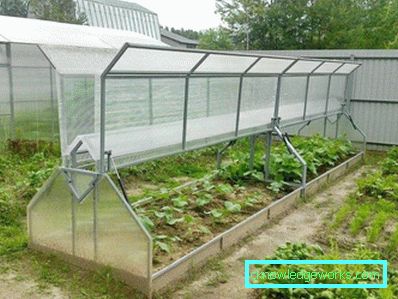
First, we will build a box of planks 30x200x100 cm. To increase reliability, the corners can be additionally fixed with “corners” or with wood bars. On the sides and in the center, install the support frames from the bars (60x120-140 cm). Connect the top corners with laths or sheathe polycarbonate. Now set the slope of the bars to secure the cover of the greenhouse. The ends are closed with film or polycarbonate. Then carefully attach the film to the roof. Secure free edges on the rail, which you need to attach with light hooks to the top face of the box. To care for plants and greenhouse ventilation, the covering can be lifted and fixed at the top.


Also for the cultivation of cucumbers often construct greenhouses. They are suitable not only for obtaining an earlier harvest, but also the growing season of this plant from early spring to late fall.
Summer residents often install ready-made purchased polycarbonate structures, but to build a tunnel greenhouse for cucumbers in reality and with their own hands. The main problem is financial, because money is needed to purchase the necessary materials, but believe me, buying a ready-made greenhouse will cost more.
For the construction will be needed such materials:
- foundation material (concrete);
- PVC pipes for the erection of arches;
- iron fittings;
- bars 10x10 cm for the bottom;
- 4x4 cm bars for doorways and windows;
- self-tapping screws;
- greenhouse cover material;
- thin strips for attaching film material.
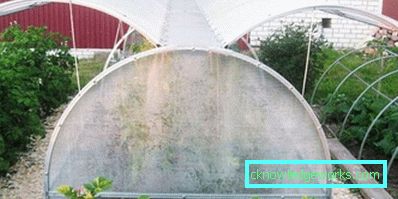
The process of building a greenhouse begins with the preparation of the foundation. Lay it must be 20 centimeters high, when pouring, set the vertical support bars vertically every two feet on both sides. Put PVC-pipes on these supports, forming arches. From the 10x10 cm bars along the lower edge of the structure, make a harness. To ensure reliability along the entire length of the frame, connect the arches with additional PVC pipes - at the highest point of the arches and on the sides - at a height of 0.75 and 1.5 m. Build a door in one end of the frame, and a window in the other. If the length of the greenhouse allows, 2-4 vents can also be mounted on the roof. Attach the film and prepare the beds for cucumber seedlings.
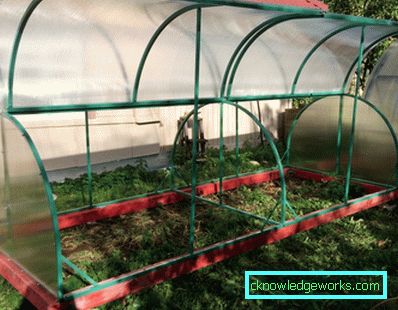

Additional equipment must be installed in the greenhouse:
- first, the heating system of the internal space (for example, the “warm floor” system or steam heating pipes);
- secondly, lighting lamps (fluorescent or phytolamps can be used);
- thirdly, to build an irrigation system.
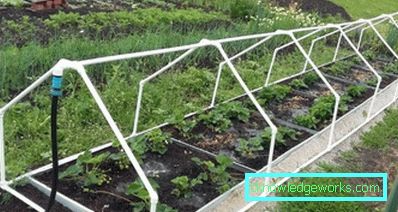
The heated greenhouse will allow you to enjoy cucumbers all year round. If you live in the city, in the apartment, but like to mess around in the garden, do not despair. Even at home you can equip a small greenhouse for cucumbers.
For it you will need: an unnecessary shelf, film, a high soil tray and a heated balcony or loggia. You can use a ready bookcase, or you can assemble it yourself from scrap materials - wooden bars or plastic pipes. The simplest option is two arches 1.8–2 m high, the base width is 0.9–1 m. You can make a box with dimensions of 90-100x60x30 cm, to the corners of which you can attach arches. For reliability, they are reinforced with horizontal bars at a height of 6, 12 and 18 dm. The construction is covered with a greenhouse film, erecting a “door” with “velcro” on one end for planting care and ventilation.

Under the box you need to attach a device for heating. - incandescent lamp in a waterproof case (preferably tin) or a fan heater. At the zenith of the greenhouse install fitolampu. You can attach additional mesh shelves for seedling pots or garter strings for growing shoots to horizontal bars. The pallet with the soil for plants is put in the bottom. With proper care, the plants planted in such a greenhouse will bring a good harvest. Consider that for home cultivation of cucumbers you need to plant self-pollinating species.

Manufacturing materials
As mentioned above, greenhouses can be built from a variety of materials - from wood to reinforcement, from plastic film to glass. It all depends on the size and timing of the greenhouse. For temporary arched structures, as well as for "butterflies", film or agrofibre are more often used. For large greenhouses - glass, polycarbonate and film. The frame material also varies from wicker bars, planks, even barrels to metal fittings.

Let's take a closer look at each material.
Greenhouse film perfectly protects plants from rain and cold. Most often gardeners prefer a single-layer transparent smooth film with a thickness of 0.08 to 0.2 mm. Of course, the thicker the material, the better it retains heat, but the price also increases greatly.
A two-layer reinforced film is also used, between which a strong nylon mesh is fused. Air bubble film consists of 3 layers, between them an air gap in the form of bubbles, which are responsible for the retention of heat.
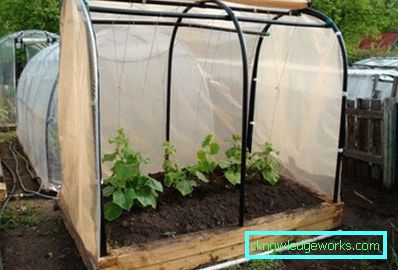
A light-converting film is also used, in which material phosphors are added. They convert the ultraviolet of sunlight into a part of the spectrum that plants need more. Under such a film protection, the growth of cucumbers is accelerated, photosynthesis of proteins increases, and the microclimate created does not depend on whether the sun is shining or the weather is frowning.
Agrofibre is a nonwoven fabric. For greenhouses used white agrofibre, the thickness of which is at least 0.06 mm. Summer residents love him for the fact that it is water- and breathable, provides protection both from low temperature and from too hot rays of our star. This is a reusable material.

If you visit your garden only on weekends, the best option for you is agrofibre. After all, in case of heat, the film must be lifted, and it must be regularly watered, and the nonwoven fabric and moisture of the rains will pass, and will protect from temperature fluctuations.
Glass does not need to be praised - its strength, ability to protect well against low temperature, precipitation, wind gusts have long been known. Of course, its price is high, but many gardeners collect greenhouses and greenhouses from old window frames.

Polycarbonate refers to synthetic materials, it is used more in the production of finished models of greenhouses and greenhouses. The price of purchased designs is rather big, but the additional advantage is durability of products. The sheets of this transparent and strong material with a thickness of 0.4 - 0.6 cm have good heat transfer performance. But in hot weather, its advantages turn into minuses: a greenhouse with polycarbonate coating needs to be ventilated more often, and plantings should be watered. There is one more subtlety - polycarbonate should be washed with a simple damp cloth, without soap and household detergents - they cause clouding.

Dimensions
The size of greenhouses vary in a wide range - from mini-hotbeds, installed on the balcony, to the long and narrow tunnel structures. The optimal height of the greenhouse borage, as already mentioned above, is 150–170 cm. The length depends on your needs. Greenhouses are usually made large and high - small ones do not pay off the invested funds and efforts. They are also distinguished by a more rigid structure.
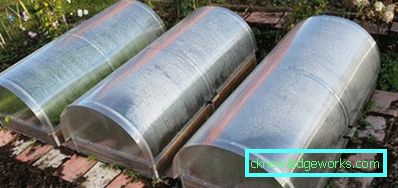
Selection and preparation of location
Choosing a place for borage, follow some simple rules. The main condition when choosing the location of the greenhouse is the degree of light exposure during the day. Also pay attention to the flow through area. Low places with a constant inflow of water, not protected from the wind, are not suitable for arranging a greenhouse. Orient borage to the east. If this is not possible, arrange the structure of the greenhouse so that the sun's rays warmed it in the first half of the day.

Do not place a greenhouse on a slope, the surface of the earth should be fairly flat, without thickets nearby. Equip the approach to the greenhouse for transporting manure and organizing watering.
Little trick: make the northern edge of the greenhouse slightly elevated compared to the southern - a little, by 10 centimeters. This will serve to increase protection from the cold, improve warming with sunlight, and clean the surface from precipitation.
Before building a greenhouse, take care of the soil for the cucumber beds. To do this, mix sand, humus and earth. Do not overdo organic fertilizers - their excess amount will have a negative effect on plants. You can also make a soil mixture for cucumbers from turf, humus, sawdust and peat. There are a lot of recipes.
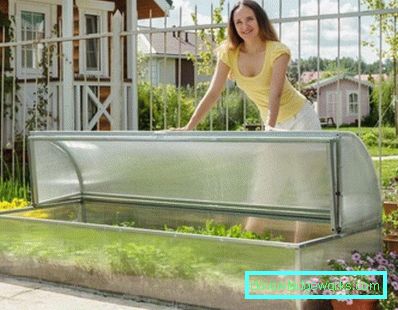
Examples of finished models
There are many ready-made models, from portable mini-greenhouses to large greenhouses. Take a closer look at some of them.
- "Snail" - refers to the mini-greenhouses. This portable model with a hinged roof is usually used for sprouting seedlings. The dimensions of the "snail" are convenient for transportation - 2.1 x1.1x, 85 m. It is very easy to assemble it. Polycarbonate sheets are also included.

- "Butterfly" is a tunnel structure with side walls (solid or divided into sections) that rise up. When tilting the walls, they are supported by specially installed supports. Common dimensions: width - 125 cm, height - 115 cm, length varies - 2, 4 or 6 m.
- In the gardens, you can often see a greenhouse, "breadbasket." It is distinguished from the "butterfly" by the structure and the method of opening - one of the walls slides along the guides and covers the second. Dimensions: width - 130 cm, height - 75 cm, length - 4 or 6 m. Due to the low height, this greenhouse practices horizontal plant development, which is achieved by reducing the density of the seedlings.
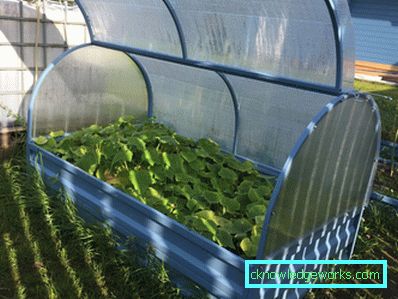
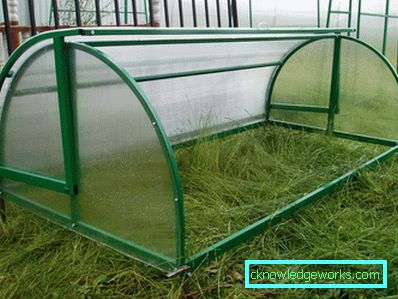
- The design of the Belgian greenhouse provides slope on one side. For ventilation and courtship for cucumbers, the slope is raised. Length - 2 or 4 m, height - 110 cm, width - 120 cm.
- "Cabriolet" refers to prefabricated greenhouses, the base is made of metal pipe 2x2 cm, and the semicircles are made of plastic. There are various modifications - with one- and two-way openability. Dimensions are standardized: width - 130 cm, height - 120 cm, length options - 160, 330 or 400 cm.

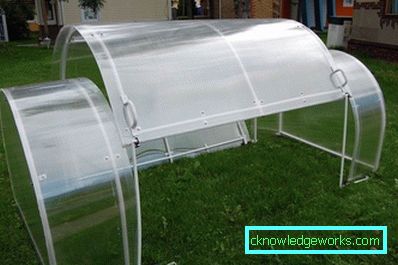
- "Gherkin" - arched greenhouse under the film. The frame is usually made of galvanized profile. Standard sizes - 5x1x1.2 m, length variations are possible. Most often they sell only the frame of the greenhouse, without covering material. The “cucumber” is not a winter greenhouse, the film or agrofibre needs to be removed, otherwise the mass of snow that fell out may deform it.
- "Agronomist" is a construction of plastic pipes. Its peculiarity lies in the fact that the frame is sewn into covering material with UV protection. The coating can be lifted simply by moving the supports to the desired height and fixing them with special clamps. Length options - 4, 6 or 8 m, height - 80 cm, width - 110 cm. Dismantling is necessary for winter

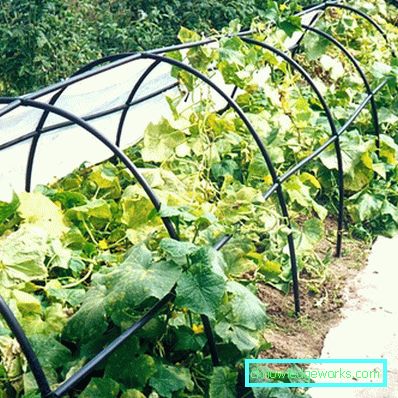
- "Dayas" is analogous to "agronomist", the difference is only in size (length - 4 m, width - 120 cm).
- "Snowdrop" - arched greenhouse, the set of which does not include covering material, only arcs are sold. The length is 3, 4, 6 or 8 m, the height is 80 cm, and the width is 120 cm. Wind resistance is rather low, in strongly blown areas additional measures are needed to strengthen the greenhouse. Not designed for winter, so before the cold it needs to be disassembled. Another name "snowdrop" - "hawk".
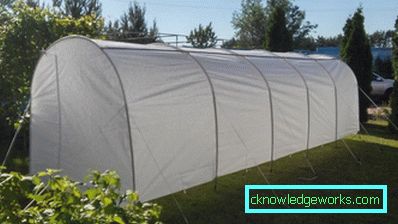
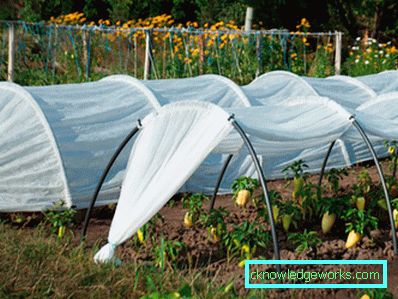
Also in the stores you can purchase just sets of arcs from which you can build a greenhouse of the size and configuration you need.
How to make a greenhouse for cucumbers, see the following video.